This post may contain affiliate links. Please read our disclosure policy. As an Amazon Associate, I earn from qualifying purchases.
America has a love affair with cheesecake! And that includes all manner of flavors. This creamy Lavender Cheesecake has a light, floral flavor and it is one of our special summertime flavors.
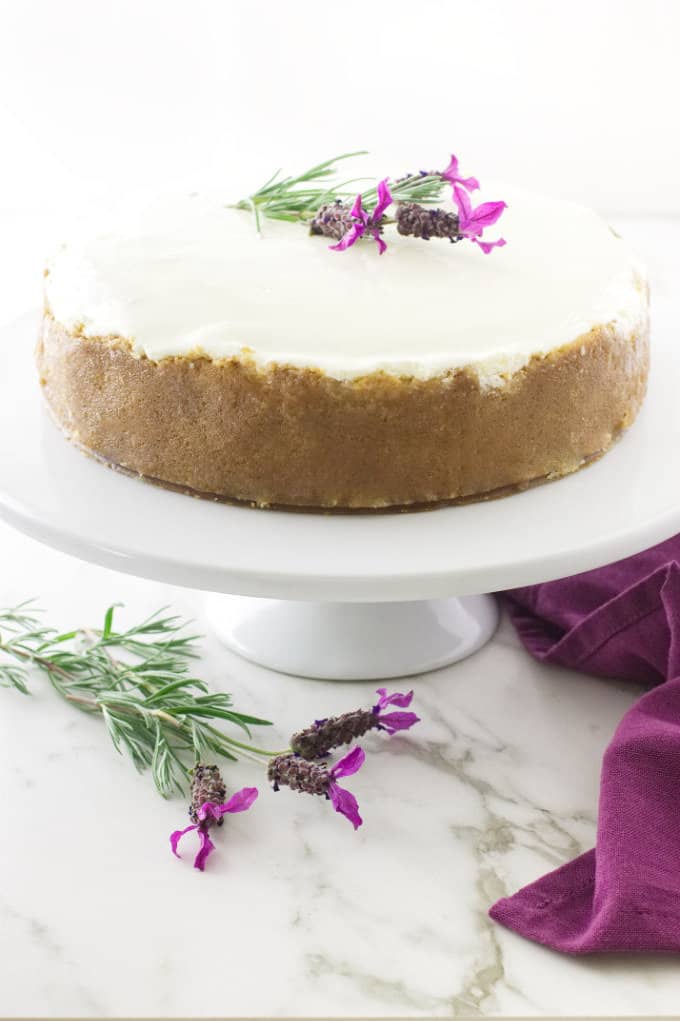
The romantic fragrance of lavender is in the air at our house as the lavender tree on my deck is once again blooming bright and beautiful! That wonderful lavender fragrance always inspires me to create something delicious, and this lavender cheesecake was calling to me.
My lavender tree, Lavandula stoechas, is not of the culinary variety and not what I used in our recipe. But I have garnished the cake with its beautiful purple flowers. In our lavender cheesecake, I used the dried buds of a culinary variety of lavender for that light floral flavor.
Cooking with Lavender:
Lavender is an evergreen perennial herb cultivated both for ornamental garden plants and as a culinary herb. It is also used commercially for the extraction of essential oils.
Although most varieties of lavender can be used in cooking, there are a couple species that create more flavor in foods. Specifically, the Lavandula angustifolia and Munstead have the sweetest fragrance in their flowers which contribute to the flavor in foods.
Commercial lavender growers most likely spray their plants with pesticides. For this reason, it is not recommended to use lavender from garden stores, nurseries and florists for culinary purposes.
The foliage of the lavender ranges in color anywhere from bright green, to grayish green to silvery green. Beautiful fragrant flowers are in varying shades of lavender from light pinkish lavender to beautiful deep purple.
Lavender is a Herb:
Lavender is in a group of familiar culinary herbs that we use every day:
- Basil
- Mint
- Oregano
- Sage
- Thyme
- Rosemary
The foliage of the lavender herb most resembles the rosemary herb and can be added to dishes for a unique subtle flavor.

About Our Lavender Cheesecake:
Cheesecakes are a mixture of cream cheese, sugar, eggs and flavorings. Use a full-fat cream cheese. If you are going to indulge in this calorie-laden treat, go all the way. I honestly do not believe there is such a thing as a diet-friendly cheesecake.
Sour cream or heavy cream is often added which gives a lighter texture while adding moisture to the cake. Cheesecake is an eggy custard and my rule is to use one egg per eight-ounces of cream cheese, plus one or two extra egg yolks for creaminess.
A little starch in the form of flour or cornstarch helps bind the cake together giving it structure. The starch also will make the slices clean and neat. Only a tablespoon of starch will make a difference in texture without compromising taste.
Our lavender cheesecake contains a half-cup of sour cream and one tablespoon of cornstarch. That doesn’t seem like much but it makes a difference in the texture and gives this cheesecake an incredibly light, smooth, creaminess. A little starch also makes the cheesecake firmer for easier slicing.
The most noticeable thing the starch will do, however, is absorb extra liquid. Since this cheesecake has sour cream in it then it has some extra liquid that will seep into the crust. If you leave out the starch, your cheesecake will have a more delicate texture but your crust might be a bit soggy.
Baking Our Lavender Cheesecake in a Water Bath:
Cheesecakes are actually egg-based custards and should bake at a low heat. The water-bath method has proven to be one of the best methods to bake a cheesecake. Heat from the water surrounding the cake pan maintains a low, even temperature.
Since water boils at 212°F the water surrounding the cheesecake acts as an insulating barrier that will prevent overheating the edges of the cheesecake.
Problems with Leaking:
A huge problem is that the design of a springform pan is subject to leaking while in the water bath. Often the method to seal the springform pan is to wrap the pan with aluminum foil. The problem with aluminum foil is that it tears easily. Even a small tear in the aluminum foil will allow water to seep into the cheesecake pan.
A Better Method to Seal a Springform Pan
There is a more efficient method than the foil wrap and that is to wrap the pan in an oven-proof plastic bag. This is the method used for our Bourbon Vanilla Cheesecake with Chocolate Ganache. If you skip over to the Bourbon Vanilla Cheesecake, check out our video to see how we wrapped the cheesecake in an oven proof bag.
I have used an oven-proof turkey roasting bag to keep the springform cake pan waterproof. Another option is the heat-proof liner bag designed for a slow-cooker.
Once the crust has baked and cooled, we set it inside the oven bag then scrunched the bag up snuggly and tied it with a twisty. We then set the whole thing into a deep roasting pan. After preparing the custard, we poured it into the cooled crust and poured hot water into the roasting pan.
Finally, we placed the cheesecake and the two pans in the oven with the hot water bath. This method can be a bit tricky because you have to transport the roasting pan while it has hot water in it. An alternate and safer technique would be to pour the hot water in the roasting pan after you place it in the oven.
Be Safe, Don’t Spill Hot Water on Yourself:
We tend to live on the edge and transport the roasting pan with the hot water. The primary reason we do it this way is to prevent hot air from escaping from the oven. But if you’re worried about the hot water sloshing out then go ahead and stick the pans in the oven before you add the water.
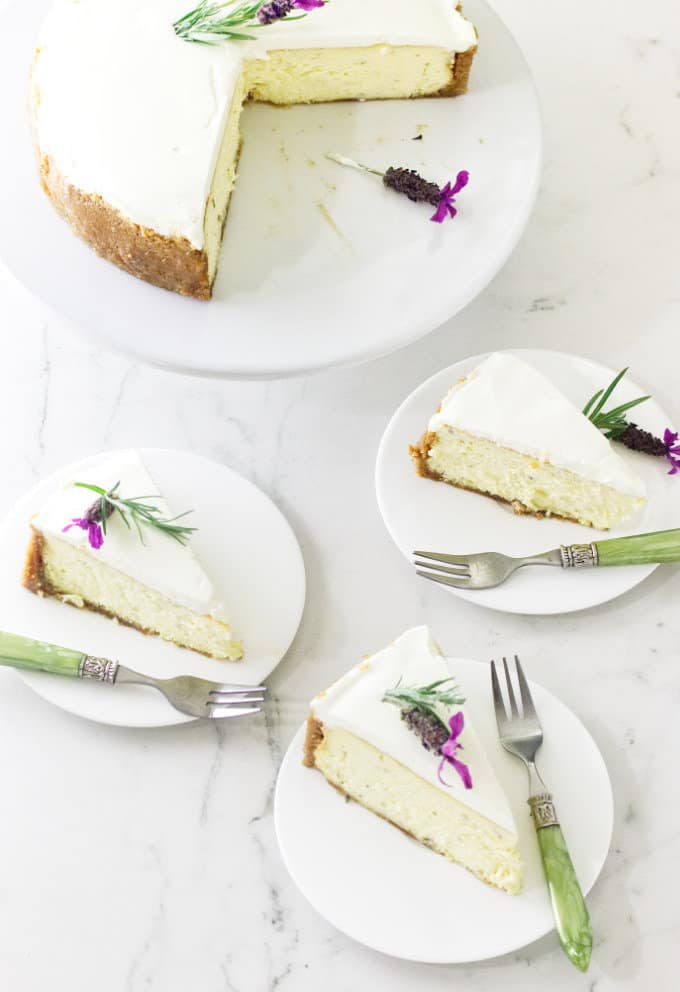
Cheesecake flavors:
When it comes to flavorings for the cheesecake the options are too numerous to list. Let your imagination take control and create a memory! Some of our favorites are:
- Vanilla Raspberry Swirl
- Espresso Bean
- Lemon Raspberry Marble
- Chocolate Amaretto
- Pumpkin
Our lavender cheesecake has a graham cracker crumb crust with a creamy, light custardy filling flavored and speckled throughout with bits of the dried lavender buds. There is a thick layer of sweetened sour cream spread over the top of the cake that contrasts deliciously with the creamy cheesecake custard.
Be cautious when adding the Lavender buds. Use the ‘taste test’ method as it is easy to overdo the flavor.
I measured out three tablespoons of buds, put them in a pesto dish and crushed them to the size I wanted. Two tablespoons of the crushed lavender buds, using the ‘taste test’ was enough to give a light lavender flavor to the lavender cheesecake.
Cheesecakes need time in the refrigerator to firm up. As the cake cools and firms up the flavors will intensify.

Can You Freeze this Lavender Cheesecake?
Definitely consider making this lavender cheesecake in advance and freezing it. Cheesecakes are a great dessert option and time saver when planning a large dinner party.
Properly wrapped and stored, a frozen cheesecake will keep in the freezer for up to three months. To prepare a frozen cheesecake for serving, remove the cheesecake from the freezer, unwrap it and let it thaw overnight in the refrigerator.
For neat slices, dip a sharp knife in hot water and wipe it off on a paper towel before cutting each slice.
More Chilled or Frozen Desserts
- Tropical Fruit Salad with Honey Yogurt Dressing
- No Churn Vanilla Lavender Ice Cream
- Lacy Lavender Cream Horns
- Bourbon Vanilla Cheesecake with Chocolate Ganache
- 31 Cool Summer Dessert Ideas
More Recipes Using Lavender:

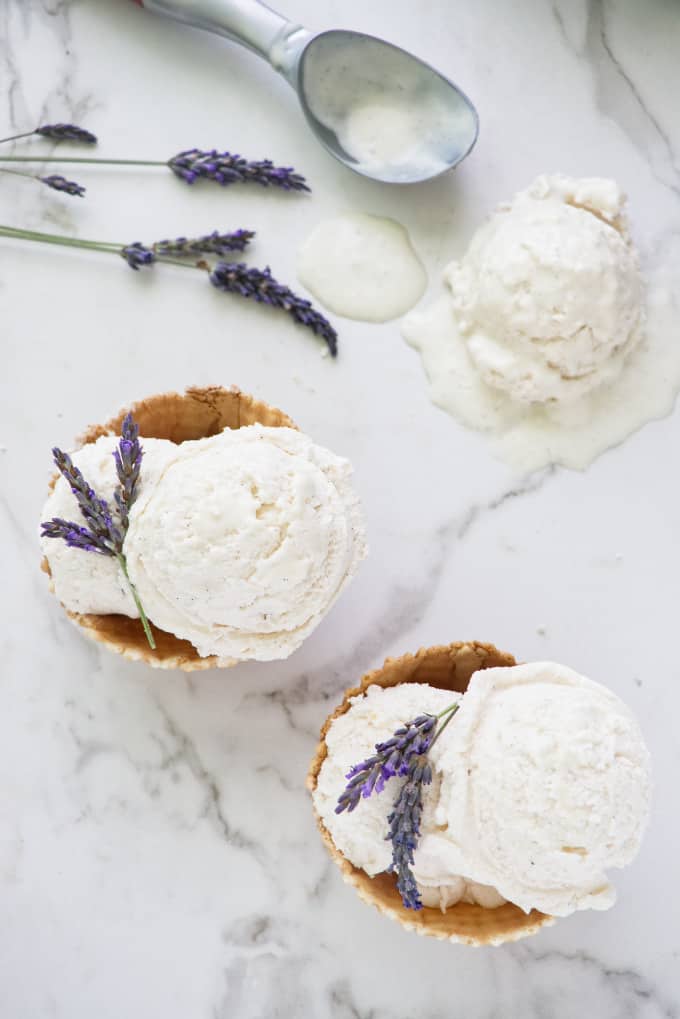
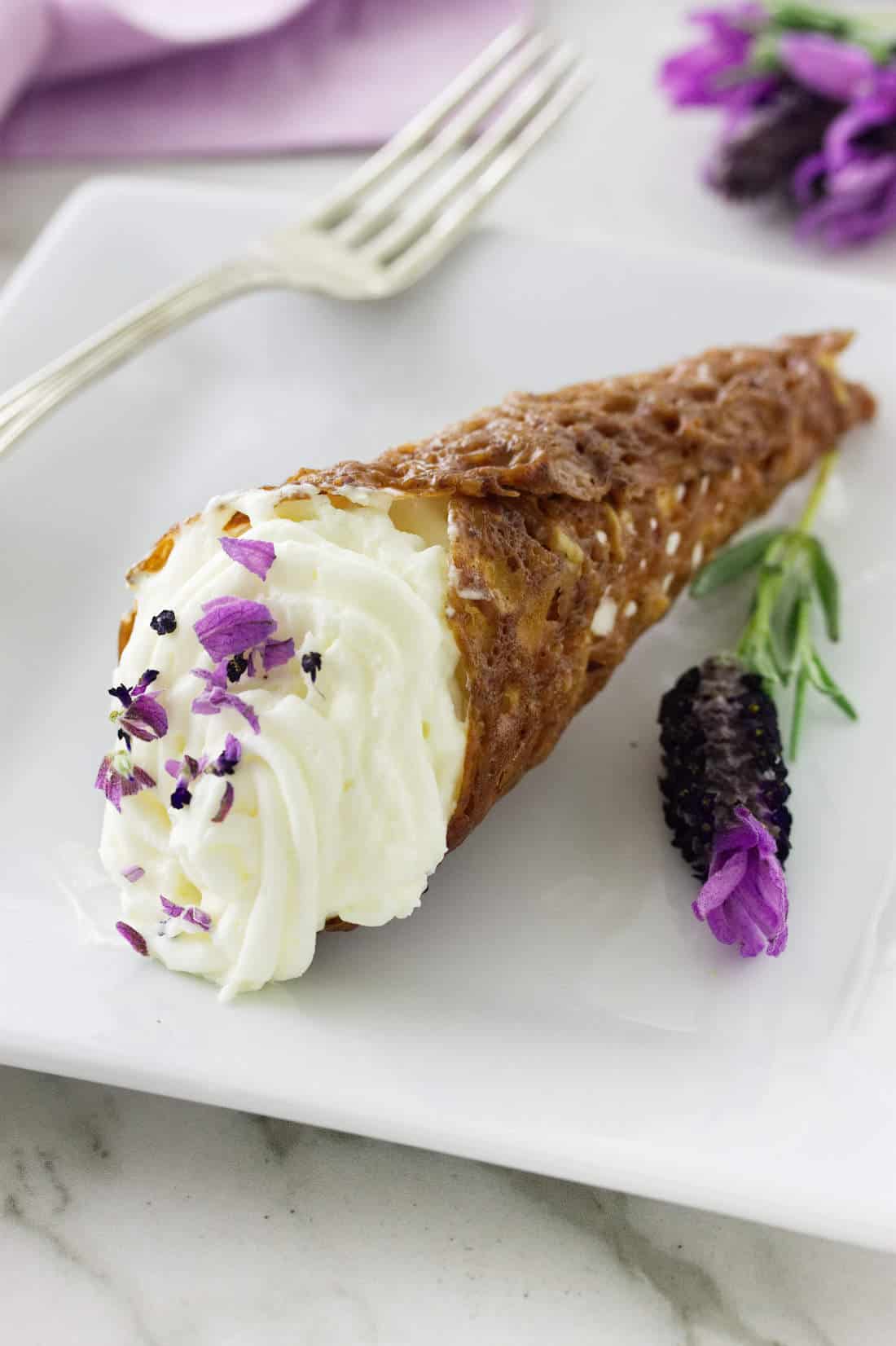
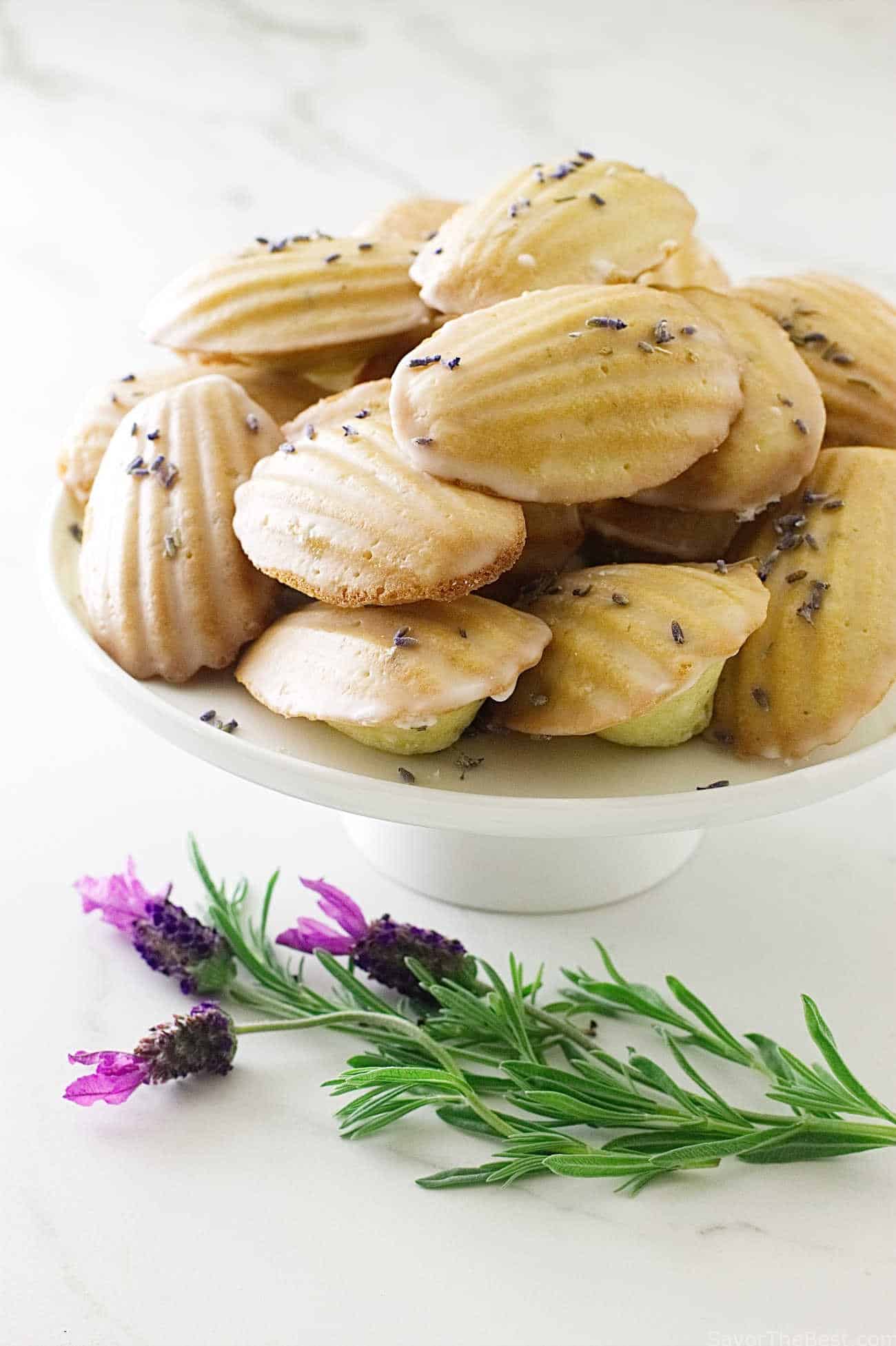
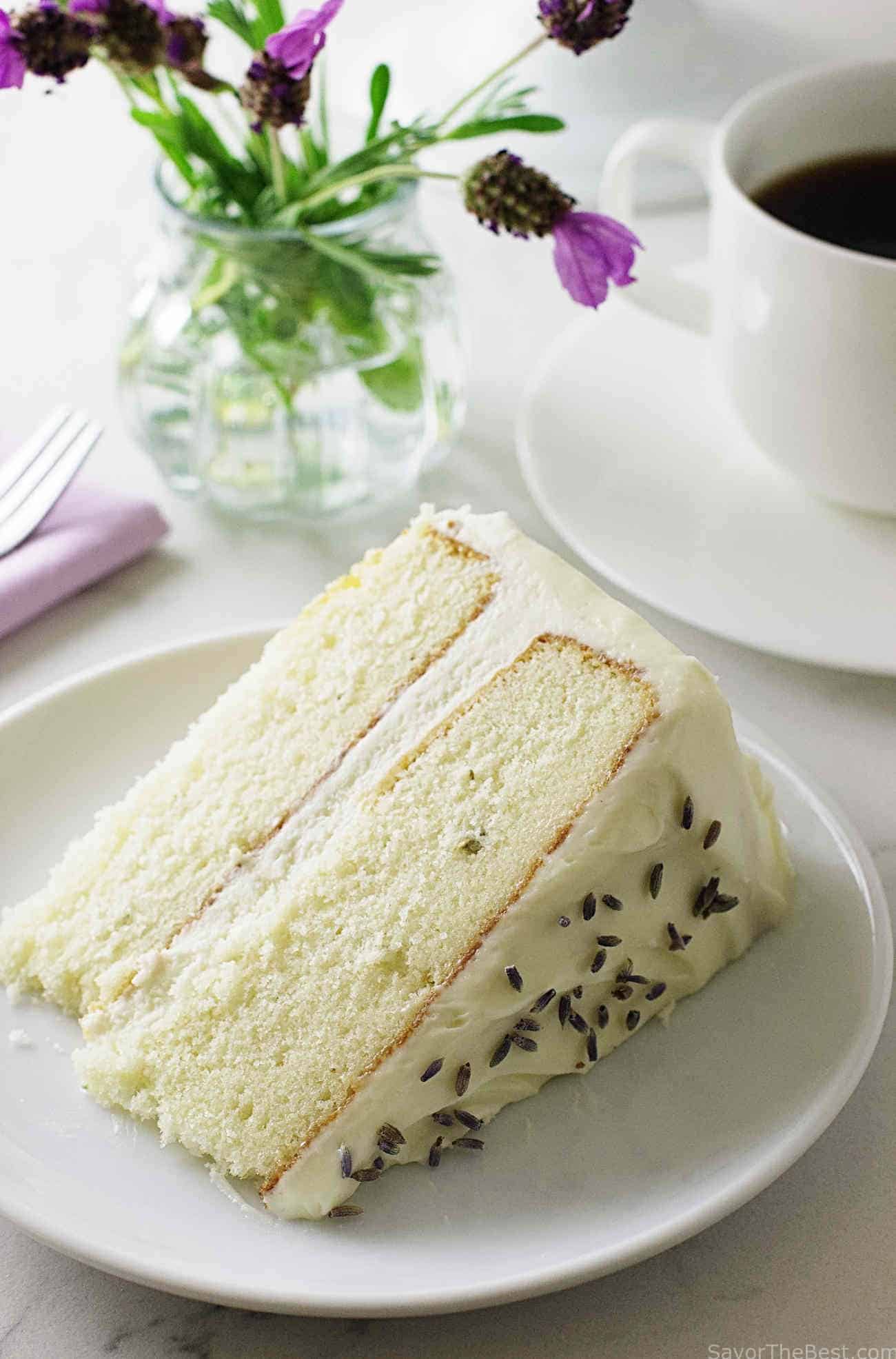
Pin this now to find it later!
Pin It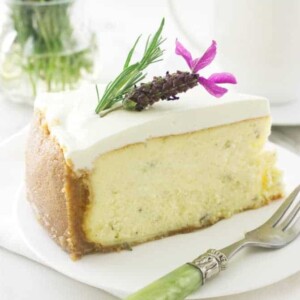
Lavender Cheesecake
If you make this recipe, please leave a star rating and comment.
Ingredients
For the Crust:
- 13 to14 whole graham crackers, crushed; about 2 cups crushed
- ¼ cup brown sugar
- 8 tablespoons butter, melted and cooled
For the Lavender Cheesecake:
- 2 tablespoons dried culinary lavender buds, finely chopped or crushed
- 32 ounces cream cheese, , room temperature
- 1 cup granulated sugar
- 1 tablespoon cornstarch
- ⅛ teaspoon salt
- ½ cup sour cream
- 1 teaspoon vanilla extract
- 4 large eggs, room temperature
- 2 egg yolks, room temperature
For the Sour Cream Topping:
- 2 cups sour cream
- ¼ cup granulated sugar
- 1 teaspoon vanilla extract
Instructions
For the Crust:
- Preheat the oven to 350°F
- Coat the sides of a 9-inch springform pan with a couple tablespoons of butter or use non-stick spray.
- Combine the graham cracker crumbs and sugar in a large bowl and add the melted butter and toss with a fork until evenly moistened. The mixture should look like damp sand and clump together when squeezed.
- Tip the crumbs into the prepared pan and press them evenly up the sides, then spread the remaining crumbs over the bottom. Press down firmly with the flat bottom of a measuring cup or the flat bottom of a glass.
- Transfer the pan to the hot oven and bake the crust for 10 minutes. Remove and set on a cooling rack while preparing the custard.
- Once the pan has cooled, set the pan inside a slow-cooker liner or turkey roasting bag, roll the top of the bag down to the edge of the pan so that the top of the cheesecake is not covered. Tie the bag snuggly around the top with a twisty wire. The oven-proof bag will prevent water from seeping into the springform pan. Set the prepared water-proof pan inside a larger, deep-sided pan such as a roasting pan.
- Arrange the oven rack to the lower-middle position of the oven and reduce the oven heat to 325°F.
- Chop or grind the dried lavender buds and reserve. (See Notes)
- Add the cream cheese and sugar to a mixing bowl, a stand mixer if possible, and beat on medium-low speed for 1 minute until smooth. Add the cornstarch, salt, sour cream and vanilla. Beat on medium-low speed for another minute until creamy. Stop the motor and scrape down the sides and bottom of the bowl with a spatula.
- With the mixer speed still on medium-low, beat for another minute while adding the eggs and yolks, one at a time, mixing well between each addition. Do not over mix.
- Fold in the chopped lavender buds with a spatula, tasting for flavor.
- Pour the custard into the cooled crust, transfer both pans to the oven. Pour hot water into the outside pan until it reaches 2/3 up the springform pan. Bake the cheesecake for 50-55 minutes, then turn off the oven and crack the door open or prop it open with a wooden spoon. Let the cheesecake cool slowly for 1 hour then carefully transfer both pans from the oven and lift the cheesecake from the water bath. Remove the oven bag from around the springform pan.
- Let the cheesecake cool for another 30 minutes.
Prepare the Sour Cream topping:
- Increase the oven temperature to 400°F
- Combine the sour cream, sugar, and vanilla until the sugar has been dissolved. Spread the sour cream mixture evenly over the top of the cheesecake. Transfer to the oven and bake for 8 minutes. Remove from the oven and cool for 1-2 hours then cover with plastic and refrigerate overnight. (See notes)
- To remove from the pan, run a thin sharp knife around the inside of the pan, loosen the metal side ring and transfer the cake to a serving plate.
- To serve, use a thin sharp knife dipped in hot water then wiped dry, slice into wedges.
Notes
- Chop the lavender buds and reserve. Lavender buds tend to be a little chewy but a quick grind in a spice mill or pesto dish breaks them up and distributes the flavor evenly throughout the batter.
- Lavender flavor intensifies slightly with heat. Be sure to taste test when adding the lavender buds but don’t overdo it.
- When making the graham cracker crust, try adding a teaspoon of the chopped lavender buds.
- All ingredients should be at room temperature. There are a few shortcuts: Cream cheese can be quickly brought to room temperature in the microwave. Set the microwave on ‘defrost’ setting for 10 to 15 seconds. Eggs, can also be placed in a dish of warm water for 5 minutes.
- Be sure to blend the cream cheese and sugar to a smooth texture.
- Add the eggs one at a time, fully incorporating each egg before adding the next.
- Blend the ingredients on slow speed as a high speed will add air into the batter which will cause the cheesecake to puff up during baking and crack during cooling.
- Baking the cheesecake in a water bath, (bain-marie), makes a creamy and moist cake as the water bath provides an even heat and keeps the surface of the custard moist.
- Do not over bake the cheesecake. A 9-inch cake will cook for 55-60 minutes; the center 2 or 3 inches will be a little giggly but will firm up as it cools.
- Cool the cheesecake for several hours before transferring it to the refrigerator. If cooled too fast or in a drafty area the cake may crack.
- I covered my cake with a large inverted dinner plate until ready to remove from the springform pan.
- The refrigerated cold cheesecake will slice easily by dipping a sharp knife in hot water and wiping it off before each slice is made.
- Enjoy every bite!
Nutrition
Nutrition information is automatically calculated, so should only be used as an approximation.
 Like this recipe? Rate & comment below!
Like this recipe? Rate & comment below!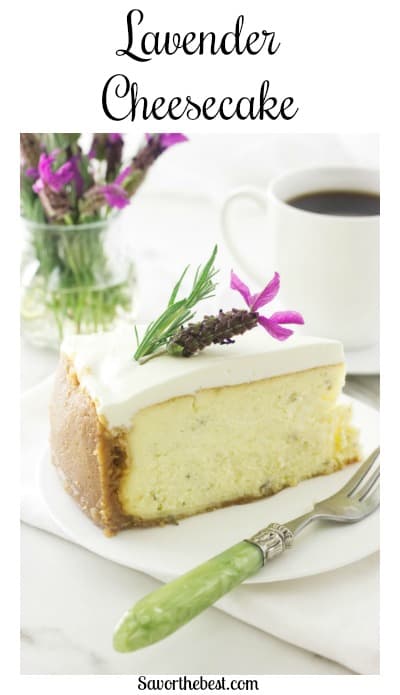

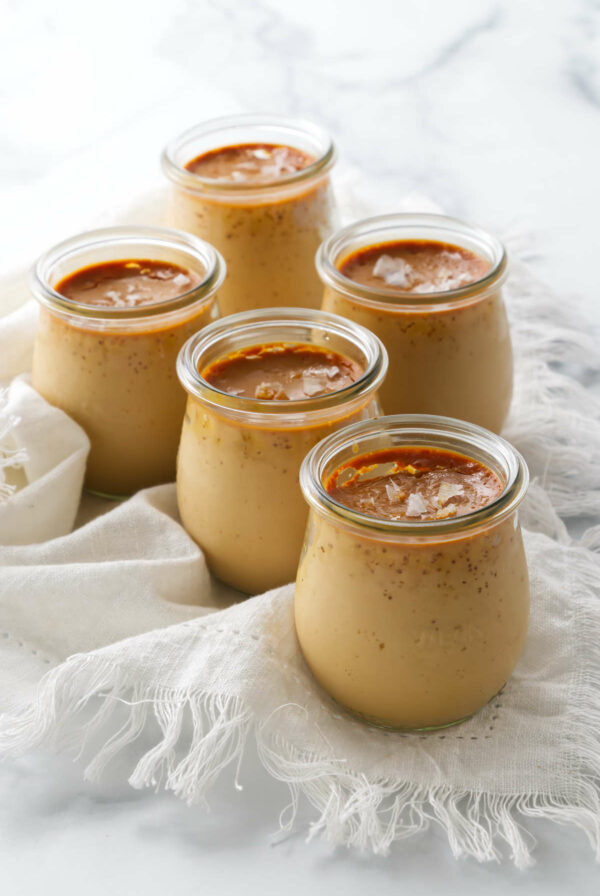
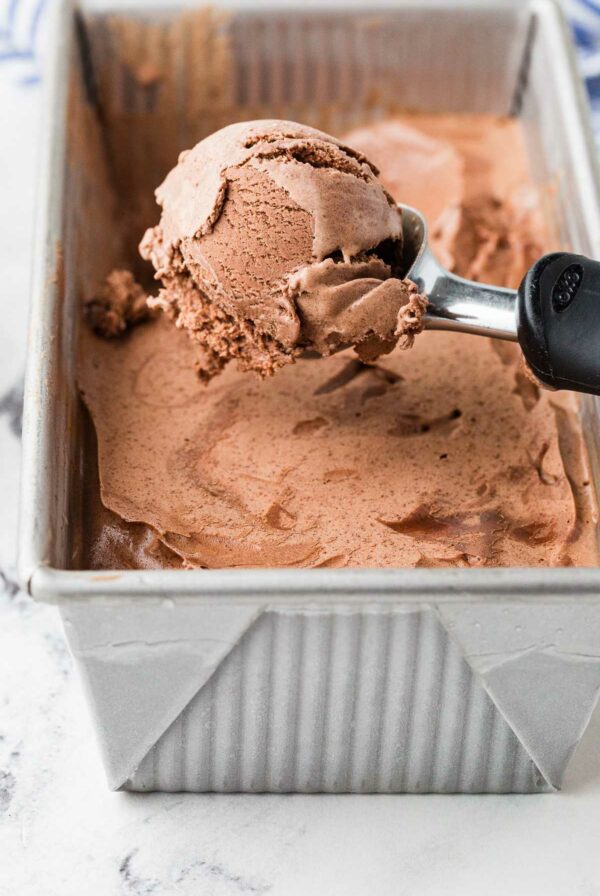
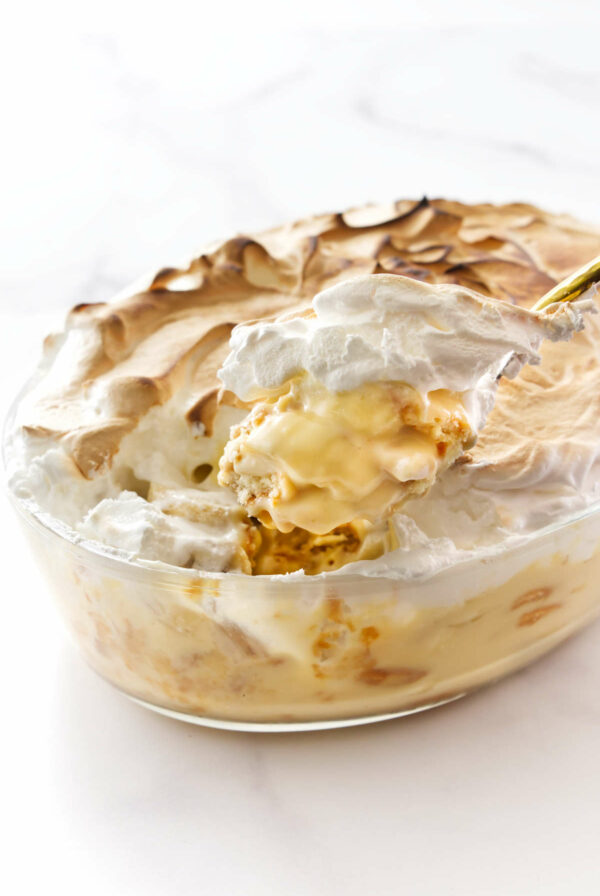
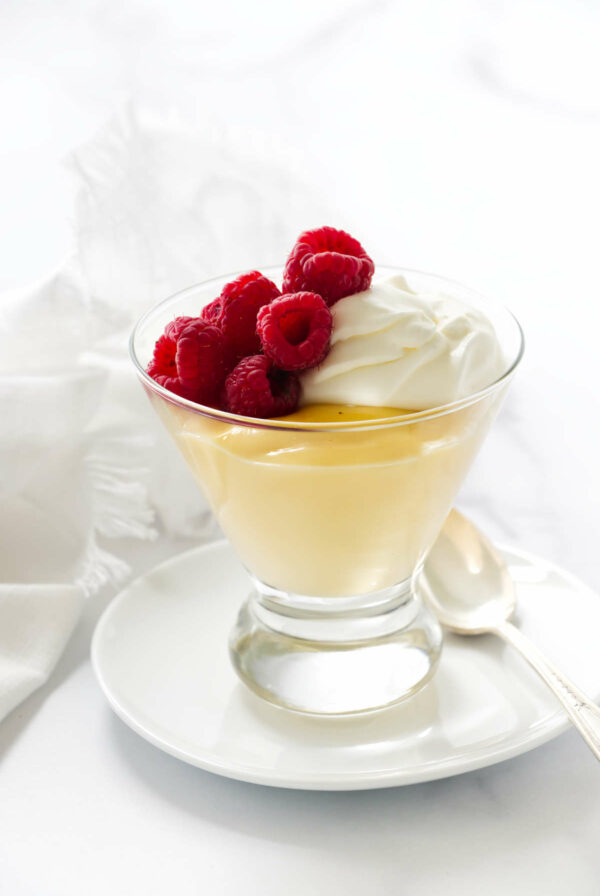










can you use liquid lavender extract instead of buds
Yes, if it is culinary grade extract but be cautious with it because liquid extract can have a potent flavor. I don’t know how much you should use but I would only put in a few drops at a time.
What is a cube of butter?
Hi, Jessica…I’m so glad you asked that question, 1 cube is 4 ounces. I added that info to the recipe card. Thanks for your feedback ?
Mmm, this looks super tasty! I remember the first time I ever had lavender-flavoured food: it was lavender shortbread as a kid, and that flavour has been something I’ve enjoyed ever since. Would love to try lavender cheesecake 🙂
Oh that sounds fabulous, I love lavender shortbread. It is such a great flavor with desserts. Thanks for the comment
This sounds amazing! Looks delicious too!
Thank you, LeAndra…..It is delicious, a very unique flavored cheesecake. 🙂
Love cheesecake. I like it with cream cheese or ricotta. Plain or flavored. With a topping or not. They’re all good! Haven’t had one flavored with lavender — neat idea. This looks terrific — thanks.
Hey, John…I totally agree with you. Sweet, rich and decadent cheesecakes! I have not had one yet that I haven’t loved 🙂